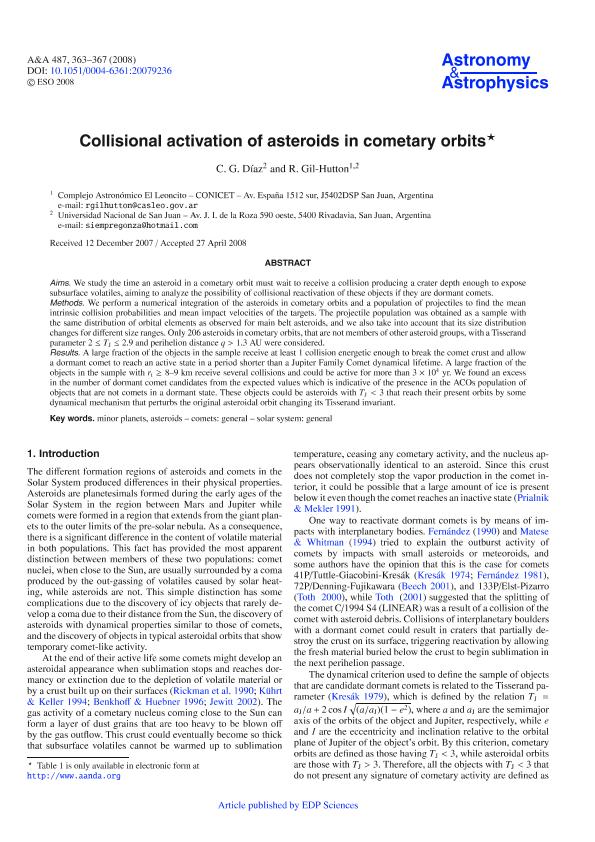Artículo
Collisional activation of asteroids in cometary orbits
Fecha de publicación:
08/2008
Editorial:
EDP Sciences
Revista:
Astronomy and Astrophysics
ISSN:
0004-6361
Idioma:
Inglés
Tipo de recurso:
Artículo publicado
Clasificación temática:
Resumen
Aims. We study the time an asteroid in a cometary orbit must wait to receive a collision producing a crater depth enough to expose subsurface volatiles, aiming to analyze the possibility of collisional reactivation of these objects if they are dormant comets.Methods. We perform a numerical integration of the asteroids in cometary orbits and a population of projectiles to find the mean intrinsic collision probabilities and mean impact velocities of the targets. The projectile population was obtained as a sample with the same distribution of orbital elements as observed for main belt asteroids, and we also take into account that its size distribution changes for different size ranges. Only 206 asteroids in cometary orbits, that are not members of other asteroid groups, with a Tisserand parameter 2 2.9 and perihelion distance > 1.3 AU were considered.Results. A large fraction of the objects in the sample receive at least 1 collision energetic enough to break the comet crust and allow a dormant comet to reach an active state in a period shorter than a Jupiter Family Comet dynamical lifetime. A large fraction of the objects in the sample with 8-9 km receive several collisions and could be active for more than 3 10 yr. We found an excess in the number of dormant comet candidates from the expected values which is indicative of the presence in the ACOs population of objects that are not comets in a dormant state. These objects could be asteroids with < 3 that reach their present orbits by some dynamical mechanism that perturbs the original asteroidal orbit changing its Tisserand invariant.
Palabras clave:
COMETS: GENERAL
,
MINOR PLANETS, ASTEROIDS
,
SOLAR SYSTEM: GENERAL
Archivos asociados
Licencia
Identificadores
Colecciones
Articulos(CASLEO)
Articulos de COMPLEJO ASTRONOMICO "EL LEONCITO"
Articulos de COMPLEJO ASTRONOMICO "EL LEONCITO"
Citación
Diaz, Carlos Gonzalo; Gil Hutton, Ricardo Alfredo; Collisional activation of asteroids in cometary orbits; EDP Sciences; Astronomy and Astrophysics; 487; 1; 8-2008; 363-367
Compartir
Altmétricas




